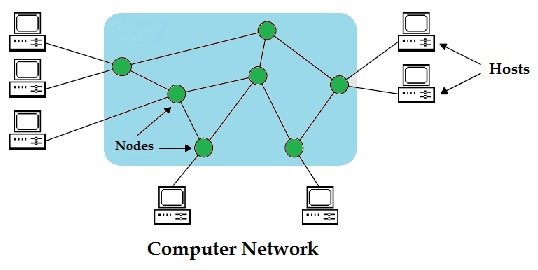Computer Networks | Network Topology | Computer Networks Assignment Help
Computer Networks
A Computer Networks are defined as the infrastructure that allows two or more computers (called hosts) to communicate with each other. The network achieves this by providing a set of rules for communication, called protocols. Computer Networks are distinguish according to a variety of characteristics such as the medium used to transport the data, communications protocol used, scale, network topology, and organizational scope.
The computer network made from two types of components called nodes and communication lines. The nodes typically handle the network protocols and provide switching capabilities. A node is usually itself a computer (general or special) which runs on specific network software. The communication lines may take many different shapes, types and forms, even in the same network. For Example: coaxial cable, optical fibers, copper wire cables, radio channels, and telephone lines.
A host is connected to the network by a separate communication line which connects it to one of the nodes. Each host has a unique address allocated to it by the network.
Computer Networks can be classified in different types based on hardware and associated software technology used in networks.
1. Geographic spread of nodes and hosts.(LAN, MAN, WAN, and SAN)
2. Access restrictions. (private networks/public networks)
3. Communication model employed by the nodes.(based on point-to-point model/broadcast model)
4. Switching model employed by the nodes. (based on circuit switching/packet switching)
The OSI Model
The OSI (Open System Interconnection is a technology standard maintained by the International Standards Organization (ISO).) model defines a networking framework for implementing protocols in seven layers. The OSI is an abstract model of how network protocols and equipment should communicate and work together.
The OSI Model consists of seven distinct layers stacked on one another: Physical, Data link, Network, Transport, Session, Presentation, and Application. Each layer uses protocol communication to perform functions related to physical communications, such as constructing packets and transmitting packet-containing signals.
In details, the OSI Model contains seven layers in two groups:
Upper Layers –
-
7. Application Layer
6. Presentation Layer
5. Session Layer
Lower Layers –
-
4. Transport Layer
3. Network Layer
2. Data link Layer
1. Physical Layer
The OSI model was designed to ensure different types of equipment (such as network adapters, hubs, routers and other digital devices) would all be compatible even if built by different manufacturers.
Students can easily learn online computer networks, networks architecture, and get guidance and help in network design through our expert computer network tutors. We provide quality Computer Networks Assignment Help as well as give option to sort out their problems based on computer networks and network topology.
Our support services at Assignmenthelp.net is world-class. You can access our help services around the clock (24*7) without any hesitation. You can also find quality assignment/homework and tutoring help in Computer Networks Assignment, Online Computer Networks, Networks Course, Networks Problems, Network Topology, TCP/IP Protocols, Networks Layers Assignment Help, Computer Network Architecture through our expert online computer networks tutors.
Students can visit for more information about Computer Networks Assignment Help, Computer Networks, Network Topologies, and TCP/IP Protocols.

